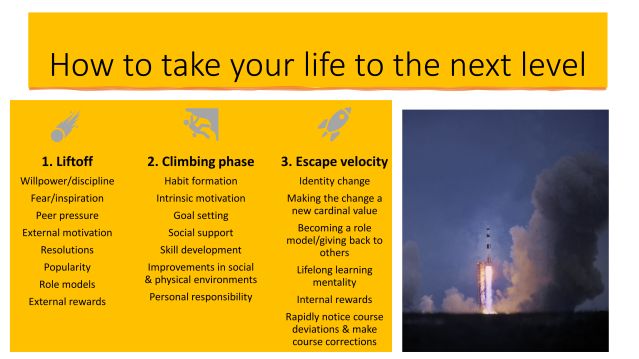Escape Velocity: The Physics of Personal Change

Escape Velocity: The Physics of Personal Change
2024 is shaping up to be an unpredictable year. Between overseas conflicts, a historically divisive presidential election, climate change concerns, and the rapid rise of artificial intelligence, it seems impossible to forecast the world we will inhabit this time next year.
Yet amidst all this uncertainty, there is still one prediction we can confidently make about 2024: A lot of Americans will try to improve their lives through behavior changes next year. Few will succeed.
I want to:
a) Simply and practically explain why failure and short-term results are the typical outcomes of behavior change efforts.
b) Show you how to join the long-term behavior change success club.
What do the following behavior change goals have in common?
- Eat healthier
- Stop procrastinating
- Get organized/stop wasting time
- Lose weight
- Be happier
- Get into shape
- Stop smoking/drinking/vaping
If you recognize that each is a popular New Year’s resolution, give yourself a point. That’s the easy one. If you also knew that the long-term success rate for changing each behavior is less than 20 percent, a fact less commonly known, congratulations.
You’ve done your homework and earned a second point. Finally, for a maximum score, did you also realize that, despite smartphones, the internet, fitness wearables, and social media influencers, we are no better at changing these behaviors than we were decades ago?
This last point probably sounds discouraging. Why bother trying if success rates are low and neither knowledge nor technology seem to help? Does success just come down to luck or good genes? Yet, as demoralizing as this statistic may appear on the surface, it also provides insights into why a subset of people manage to succeed at improving the quality of their lives while the equally well-intended majority struggle1-2.
Using rocket ships and astrophysics as metaphors, the figure below provides a roadmap illustrating how long-term behavior change occurs (and why it usually doesn’t). Study the figure for a moment. Then, let’s review some critical points.

Source: Courtesy of Thomas Rutledge
1. First, notice that almost everyone begins their behavior change efforts in a place we can call the liftoff stage. Like the initial launch phase of a rocket, the liftoff stage for behavior change is very energy and resource-intensive. Motivation, willpower, deliberate effort, “wake-up calls” in health events, and medical diagnoses are inspirational events. New Year’s resolutions, popular social media trends, success stories, contests, and incentives are great examples of resources that power liftoff efforts.
However, because the energy demands of the liftoff stage are so high – like a rocket ship burning through thousands of gallons of fuel to achieve liftoff. A person can’t stay in this stage for long without running empty. Instead, it is essential for a person to transition from relying only on liftoff stage strategies to adopting climbing phase and escape velocity stage strategies to maintain their progress.
Based on this figure, the first and most common factor limiting behavior change success is this: Most people never replace their liftoff stage strategies. Because liftoff strategies are best suited only for initial change efforts, people run out of emotional fuel and crash back to baseline. Liftoff strategies alone (e.g., New Year’s Resolutions and motivation) will rarely be sufficient for a person to achieve long-term behavior change.
2. Secondly, climbing stage and escape velocity stage strategies help people shift from deliberate, energy-intensive behavior to automatic, easy behavior change. Developing new habits, for example, shifts the behavior change process from conscious to unconscious. From a state of effort to a state of flow. From intentional to reflexive.
At the highest level (escape velocity stage), a person even graduates from creating a behavioral habit to creating a new identity where the behavior is a new personal standard and a core value. In fact, until intentional behaviors and habits become a part of our identity and self-image, we will be vulnerable to relapse.
Habit Formation Essential Reads
What is the second critical reason why even well-intended and well-resourced people struggle with behavior change? They focus on changing the external behavior rather than making the behavior an intrinsic part of themselves. Want to make a new behavior stick? Then, make it who you are instead of just something you do.
3. Lastly, based on this model of behavior change, a person’s ability to make lasting behavior changes can be summarized in the following formula: (Forces promoting and sustaining change. Gravity forces holding or pulling them back).
This gives us three potential ways to progress: 1) Reduce our gravity forces. 2) Increase our change forces. 3) Ideally, do both.
The third reason few people achieve their long-term behavior change goals? Their gravity forces in the form of factors such as toxic social and physical environments, self-criticism and poor self-image, addictions and mental health conditions, and negative habits are not addressed. Like unattended weeds in a garden, gravity forces eventually take over.
Summary
You don’t have to settle for another short-term resolution result this year. The science of behavior change offers practical steps for turning our behavioral change goals into permanent upgrades to our quality of life.



